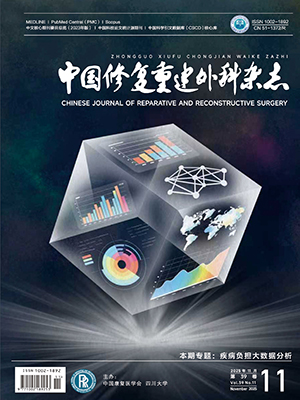Objective To investigate the effects of 3 methods (suture removal, suture removal with epineurium neurolysis, and l igated femoral nerve resection with end-end suture) in repairing femoral nerve injury after l igation in different periods so as to provide a reference for cl inical use of repairing iatrogenic l igation injury of the peri pheral nerve. Methods A total of 120 adult female Sprague Dawley rats, weighing (200 ± 20) g, were used to prepare the animal models of left femoral
nerve l igation, and were divided into groups A (n=40), B (n=40), and C (n=40) according different repairing methods. At
immediate, 1, 3, and 5 months (10 rats each time point) after l igation, suture removal was performed in group A, suture removal with epineurium neurolysis in group B, and l igated femoral nerve resection with end-end suture in group C. At 3 months after operation, the foot-base angle (FBA) and the heels-tail angle (HTA), action potential and conduction velocity of femoral nerve, and wet weight of quadriceps femoris muscle (QFM) were measured; the samples of quadriceps femoris and femoral nerve were harvested for histological observation, muscle fiber count, and nerve fiber passing rate measuring. Results The FBA in group A was significant smaller than that in group C at immediate, 1, 3, and 5 months (P lt; 0.05), but there was no significant difference between groups A and B (P gt; 0.05). The HTA in group A was significantly smaller than that in group C at immediate, 1, 3, and 5 months (P lt; 0.05), and the THA in group B was significantly smaller than that in group C at 1, 3, and 5 months (P lt; 0.05). The wet weight of QFM in group B was significantly higher than that in group C at immediate, 3, and 5 months (P lt; 0.05), and the wet weight of QFM in group A was significantly higher than that in group C at immediate and 3 months (P lt; 0.05), but no significant difference was found between groups A and B at immediate, 1, and 3 months (P gt; 0.05). There was significant difference in the action potential of femoral nerve between group A and groups B and C at immediate and 1 month (P lt; 0.05), but there was no significant difference between other groups at 3 and 5 months (P gt; 0.05) except between groups A and C at 5 months (P lt; 0.05). The conduction velocity of femoral nerve in group A was significantly faster than that in group C at immediate, 1, and 5 months (P lt; 0.05), and it was significantly faster in group A than in group B at immediate and 1 month (P lt; 0.05), but no significant difference was found between groups A and B at 3 and 5 months (P gt; 0.05), between groups B and C at other time points (P gt; 0.05) except at immediate (P lt; 0.05). The count of muscle fibre of the quadriceps femoris was significantly more in groups A and B than in group C at immediate (P lt; 0.05); it was significantly more in group A than in group B at 5 months (P lt; 0.05). The passing rate of the femoral nerve fiber was significantly higher in group A than in groups B and C at 3 months (P lt; 0.05), but no significant difference was found between the other groups (P gt; 0.05). Conclusion After femoral nerve l igation, suture removal method has the best effect at early term, the next is epineurium neurolysis method, and the worst is the l igation femoral nerve resection with end-end suture repair.
Citation: YANG Jiafu,ZHANG Chen,SUN Lin,WANG Zhijun,FU Lei. EXPERIMENTAL STUDY ON THREE REPAIRING METHODS FOR FEMORAL NERVE INJURY AFTER LIGATION IN RATS. Chinese Journal of Reparative and Reconstructive Surgery, 2012, 26(7): 837-844. doi: Copy
Copyright © the editorial department of Chinese Journal of Reparative and Reconstructive Surgery of West China Medical Publisher. All rights reserved




